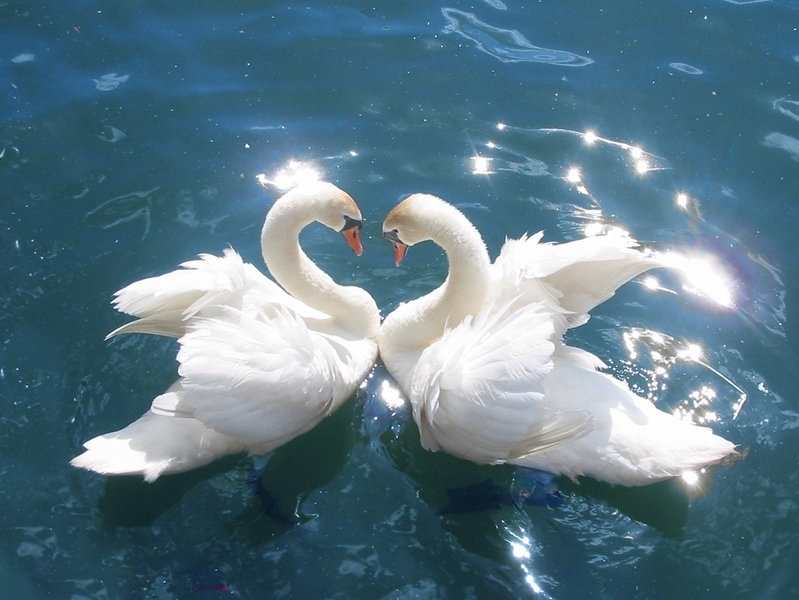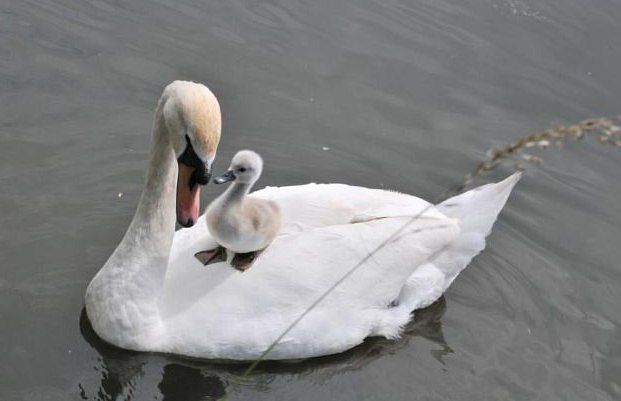



Swan
The word swan means to sound or to sing. The Mommy is a pen and the daddy is a cob.
What a peaceful looking pair of beauties sitting so calmly on the waters. The most usual thing is for them to mate for life. They have three to eight eggs in their nest. Daddy is bigger than mommy. A swan can weigh 33 pounds and have a wingspan of 10 feet. Some of them can be 60 inches long. Some kinds have black and yellow bills and others have black and red bills. There are white swans and black swans and the babies are gray.
There are several different kinds of swans, the whooper swan, the trumpeter swan, the tundra swan, the whistler swan, and the black swan. Some of the swans in the south are a mixture of black and white.
They eat roots tubers stems and leaves from aquatic sources, but sometimes they eat small animals as well. Some feed on land and in the water. Certain kinds can live to be 20 years old. Various ones will migrate short distance and some farther.
The nest is on the ground near the water and is about a meter across. Daddy is a participant of making the nest and incubating the eggs and they are very protective of their nest.


The Swan
ONE of the most beautiful and graceful, as well as one of the largest of our water birds is the swan. It is found nearly the round world over. In America it frequents the shores of Hudson's Bay in the summer and early autumn; but at the approach of winter it migrates southward to the coasts of Delaware, Maryland, and Virginia. It is also found on our western rivers.
The body of the bird is generally five feet long, and it measures seven feet from tip to tip of its outstretched wings. It is very careful of its snowy white plumage, taking great pains to keep it free from dirt. Its nest is made of reeds and rushes, and is set in some secluded spot close by the bank of a river or pond. In building, it sometimes raises the nest one or two feet to keep it from inundation. It lays six or seven eggs of a dull green color, dashed with brown. When very young, the little swans mount their mother's back, and are thus carried from place to place. They are a bluish gray, and do not don their beautiful white dress until nearly full-grown. Swans live on vegetables, but they have sometimes been seen eating small fish. In feeding, they do not dive, as ducks frequently do, but simply put the head under water, often keeping it there from three to five minutes. They are very destructive to fish, following them to their spawning grounds, and greedily devouring their eggs. In this way they have sometimes almost wholly destroyed the fish in the stream or pond where they live.
In the old country the swan is considered the special property of the Crown, and no subject is permitted to own one of these birds unless he has a special grant. With each grant is attached a "swan mark," cut in the bill of the bird, so as to show the right of the owner.
Swans always fly in a wedge-shaped flock, headed by a solitary leader. When they alight after a long flight, they do so at quite a distance from the shore, making a careful examination of their surroundings before venturing near the water. Their favorite place of hunting for food is among little ponds not far inland. At nightfall they swim from one of these ponds to another, flying when necessary. The swan is quite a high flier; but as it is a heavy bird, it is with some difficulty that it gets under way. Hunters are aware of this fact, and so lay in wait near the inlet or outlet of the pond, or in some other place where it is difficult, for, the swan to swim, when, as it rises to fly, it becomes an easy prey.
A favorite method of hunting these birds is by using a boat. In the bow of the boat is placed a cage of burning pine knots. Behind this is stretched a screen to keep the light from the eyes of the hunters, who occupy the other part of the boat. At the stern sits the paddler, who quietly pushes the boat forward toward the game. Fascinated or bewildered by the bright light, the swans swim curiously toward it. But they discover their error, when, too late to remedy it, they fall victims to the rifle-shots of the boatmen.
From this, "that other race, the human folk," might learn a useful lesson.
It seems a pity that such innocent and beautiful creatures should he sacrificed to the marksman's gun. Perhaps when people have learned that:
"what they shall eat" and "what they shall put on" is not all of life, we may hope that our feathered friends will be left unmolested.
W. E. L.
